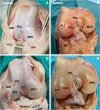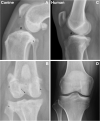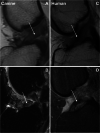Canine ACL rupture: a spontaneous large animal model of human ACL rupture
- PMID: 35123473
- PMCID: PMC8818196
- DOI: 10.1186/s12891-021-04986-z
Canine ACL rupture: a spontaneous large animal model of human ACL rupture
Abstract
Background: Anterior cruciate ligament (ACL) rupture in humans is a common condition associated with knee pain, joint instability, and secondary osteoarthritis (OA). Surgical treatment with an intraarticular graft provides reasonable outcomes at mid and long-term follow-up. Non-modifiable and modifiable factors influence risk of ACL rupture. The etiology, mechanobiology, causal biomechanics, and causal molecular pathways are not fully understood. The dog model has shared features of ACL rupture that make it a valuable spontaneous preclinical animal model. In this article, we review shared and contrasting features of ACL rupture in the two species and present information supporting spontaneous canine ACL rupture as a potentially useful preclinical model of human ACL rupture with a very large subject population.
Results: ACL rupture is more common in dogs than in humans and is diagnosed and treated using similar approaches to that of human patients. Development of OA occurs in both species, but progression is more rapid in the dog, and is often present at diagnosis. Use of client-owned dogs for ACL research could reveal impactful molecular pathways, underlying causal genetic variants, biomechanical effects of specific treatments, and opportunities to discover new treatment and prevention targets. Knowledge of the genetic contribution to ACL rupture is more advanced in dogs than in humans. In dogs, ACL rupture has a polygenetic architecture with moderate heritability. Heritability of human ACL rupture has not been estimated.
Conclusion: This article highlights areas of One Health research that are particularly relevant to future studies using the spontaneous canine ACL rupture model that could fill gaps in current knowledge.
Keywords: ACL rupture; Dog; Human; One Health; Shared features; Spontaneous animal model.
© 2022. The Author(s).
Conflict of interest statement
The authors declare that they have no competing interests.
Figures




References
-
- Murray MM, Fleming BC, Badger GJ, BEAR Trial Team. Freiberger C, Henderson R, et al. Bridge-enhanced anterior cruciate ligament repair is not inferior to autograph anterior cruciate ligament reconstruction at 2 years: results of a prospective randomized clinical trial. Am J Sports Med. 2020;28:1305–1315. doi: 10.1177/0363546520913532. - DOI - PMC - PubMed
Publication types
MeSH terms
Grants and funding
LinkOut - more resources
Full Text Sources

